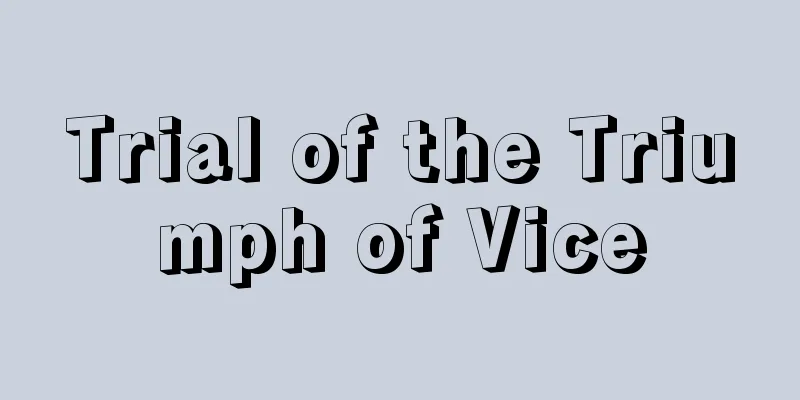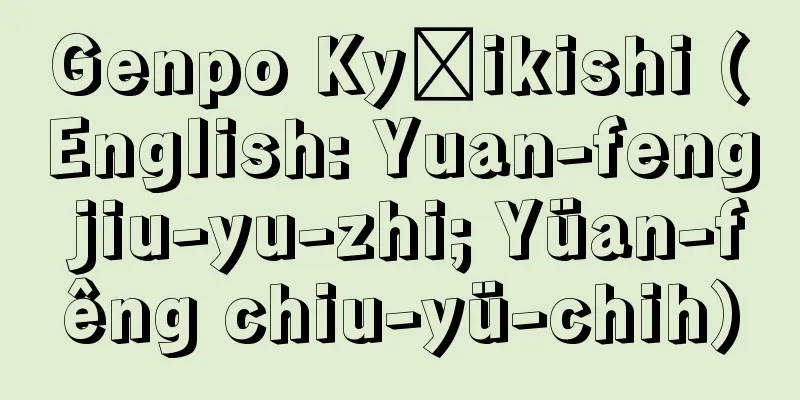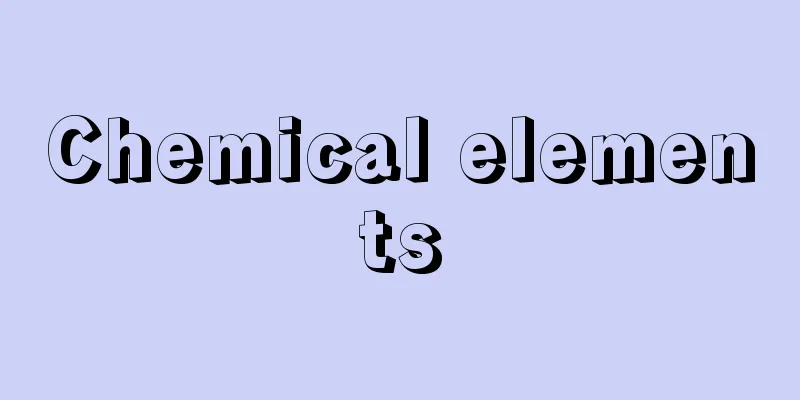Police - Keisatsu

|
It refers to administrative functions aimed at maintaining social order and ensuring the safety of people's lives, or administrative agencies in charge of such functions. When the Police Law stipulates that "the police shall be responsible for protecting the lives, bodies and property of individuals, and for preventing, suppressing and investigating crimes, arresting suspects, policing traffic, and maintaining public safety and order" (Article 2, Paragraph 1), "police" refers to the police as a type of administrative function, while when the same law stipulates that "the prefectural police shall be responsible for the duties set forth in Article 2 within the prefecture" (Article 36, Paragraph 2), "prefectural police " refers to the police agency as an administrative agency in charge of police functions. [Kenichi Sekine] The Establishment of the Modern Police Concept[1] In ancient times, especially from the establishment of the Kebiishi-cho around 816 (Kōnin 7) until the Meiji Restoration, the main administrative means for ensuring the safety of people's lives and maintaining social order were the pursuit and prosecution of criminals. Of course, even before the Meiji Restoration, there existed administrative systems and functions that are considered to belong to the "police" today, such as the self-policing and gate-guard systems, the control of gambling and prostitution, the control of adulterous and heretical cults, and the control of firearms. However, these were not conceived as a special branch of administration called the "police," but were often considered to belong to the general administration, together with the main means of pursuit and prosecution of criminals, under the concept of "control." After the Meiji period, as the legal system based on the idea of separation of powers was established, the means of ensuring the safety of people's lives and maintaining social order were divided into functions belonging to administrative power and functions belonging to judicial power. The main means up until then, the function of pursuing and prosecuting criminals, came to belong to judicial power, while the function of issuing orders and coercion came to belong to administrative power. The former is called "judicial police" and the latter "administrative police" or simply "police". This is modeled after a system based on the idea of separation of powers in France, and here the modern concept of "police" as a function belonging to administrative power was established, with the separation of powers as the institutional premise. [2] Article 2, Chapter 2 of the Regulations for the Police Bureau of the Ministry of Justice, promulgated by Dajokan Proclamation No. 17 in October 1872 (Meiji 5), stipulates that "the purpose of establishing the Police Bureau is to ensure peace and tranquility throughout the country and to protect the health of the people, thereby preventing those who disturb that peace and health." This shows the beginnings of the later concept of the police. However, at this stage the distinction between "administrative police" and "judicial police" had not yet been established, and the concept of "police" as a function belonging to administrative power had not yet been clearly recognized. [3] In January 1874 (Meiji 7), the jurisdiction of the Police Bureau was transferred from the Ministry of Justice to the Ministry of the Interior, and the Police Bureau's organizational and administrative regulations issued by the Dajokan at that time clearly distinguished between the "administrative police" and the "judicial police" following the French system. Furthermore, the administrative police regulations issued by the Dajokan Order No. 29 in March 1875 (Meiji 8) further clarified the concept of administrative police, and thus the idea of "police" as a state function belonging to administrative power was established. [Kenichi Sekine] The debate over the concept of "police" under the Meiji ConstitutionRegarding the concept of "police" under the Meiji Constitution, there was a conflict between the "academic concept of police" and the "legal or legal concept of police" based on a disagreement over the methodology of constructing the concept, and the debate between the two was never resolved. [1] The "academic concept of the police" is a concept of the police asserted mainly by Minobe Tatsukichi in relation to the interpretation of the provisions of Article 9 of the Meiji Constitution. Article 9 of the Meiji Constitution stipulated that "The Emperor shall issue or cause to be issued such orders as are necessary for the execution of the law, for the maintenance of public peace and order, and for the promotion of the happiness of the subjects." Minobe stated that "orders necessary for the maintenance of public peace and order" are orders for security purposes, and "orders necessary for the promotion of the happiness of the subjects" are orders for welfare purposes, but that orders for either of these purposes fall within the scope of the purposes of internal administration and are therefore orders for police purposes. In other words, the scope of the purposes of orders stipulated in Article 9 of the Meiji Constitution is "completely identical" with the scope of the purposes of the "police," and therefore "Article 9 of the Constitution, in the final analysis, only recognizes the prerogative of police orders beyond executive orders and administrative regulations." On the other hand, Minobe argued that the concept of police should be defined as "the action of ordering and coercing the people and restricting their natural freedom, based on the general sovereignty of the state, in order to maintain order in social life" (Japanese Administrative Law, Volume 2), because "from a legal standpoint, there is no reason to distinguish the legal nature of their actions based on whether their purpose is positive or negative." He also argued that in the concept of police, "the first element is the action based on the power of orders and coercion," and that regardless of whether its purpose is security or welfare, the power action of ordering and coercing is an action that belongs to the police, whereas non-powerful actions, regardless of whether their purpose is positive or negative, are not police actions but "childcare" actions. [2] As we have seen, Minobe, in interpreting Article 9 of the Meiji Constitution, first considers that both orders for security purposes and orders for welfare purposes are police orders, but then immediately introduces the theory of the limits of police power, especially the theory of limits on purpose (the so-called "principle of negative purpose"), and attempts to narrow the scope of the power to issue police orders. In other words, according to the doctor, police orders are orders that have the nature of legal orders, but the ability to establish laws, that is, regulations that limit individual freedom, is limited to the field of negative purposes, i.e., security purposes, and in the field of positive purposes such as welfare purposes, legal orders cannot be issued, and only administrative regulations can be enacted. As a result, the independent power to issue orders in Article 9 of the Meiji Constitution is a provision that approves the enactment of legal orders only in the field of security purposes, but this is merely the result of applying the theory of the "limits of police power" to the power to issue police orders. In this way, by arguing that the independent orders under Article 9 of the Meiji Constitution were police orders, Minobe applied the theory of the limitations of police power to this power to issue independent orders, and as a result was able to theoretically block the possibility of enacting legal orders for welfare purposes. Minobe's "theory of the limits of police power" underwent various changes as he attempted to limit the scope of the independent command-making power under Article 9 of the Meiji Constitution and to have it function as a standard for the enactment of police commands, but ultimately it was summarized into four principles: (1) limitations on purpose (the so-called "negative purpose principle"), (2) the principle of police public interest, (3) the principle of police proportionality, and (4) the principle of police responsibility (Japanese Administrative Law, Volume 2). [3] Minobe's concept of the police is called the "academic concept of the police," but it is called "academic" because, when constructing a concept as a means of academic analysis, it is desirable to subsume under a common concept those functions that are of a common nature from a legal point of view and that are subject to common legal principles and rules, and the concept of "police" in this case is also a concept that was speculatively constructed from such a point of view as a tool for academic analysis, and is a concept that has nothing to do with "police" in positive law. And, the legal characteristics common to the functions belonging to "police" in this case refer to the characteristics in three respects: purpose, means, and power, and the common legal principles and rules mainly refer to the legal principles derived from the "theory of the limits of police power." The following questions were raised regarding Minobe's views: (1) In the “concept” of the police, both welfare purposes and security purposes, that is, both positive and negative purposes, are included in police purposes. However, in the “limit theory,” the principle of negative purposes is upheld, and ultimately police purposes are limited to security purposes only. Why is this? (2) Isn’t the concept of “academic police” nothing more than the means to enforce commands, regardless of the purpose? (3) Minobe makes the above argument in order to assert that, in the interpretation of Article 9 of the Meiji Constitution, legal matters can be prescribed only for orders issued for security purposes, but only administrative regulations can be enacted for orders issued for welfare purposes. (4) In short, although Minobe’s concept of the police is an “academic concept,” it is combined with his unique method of constitutional interpretation and is a concept with an ideological character devised to limit the scope of the independent command-making power under Article 9 of the Meiji Constitution. Isn’t this method of conceptual construction fundamentally flawed as a method of conceptual construction in jurisprudence, which aims to achieve a unified understanding and order of the current legal system? [Kenichi Sekine] Legal concept of policeSoichi Sasaki's "The Concept of Police" starts from the above questions regarding "academic concepts." [1] According to Sasaki's theory, in order to clarify the concept of police, one has no choice but to look strictly at what the law thinks of as police, and what those who understand the law construct as academic concepts, or the meaning that they give to the word "police", can never be considered legal concepts. He asserts that constructing the concept of police is nothing more than clarifying what the current legal system of our country indicates by the word "police". He also states that the basic law that should be the basis of the current legal system is the Administrative Police Regulations of 1875 (Meiji 8). The concept of police that Sasaki constructed based on the Administrative Police Regulations is as follows: "Police refers to the comprehensive activities carried out by the state, centering on restricting the freedom of natural actions of people by using power to interfere with the facts that are the cause of obstacles to the order of social life under general governance, in order to remove those obstacles" ("Outline of Police Law"). Sasaki called this the "legal concept" or "legal concept" of the police, and argued that the concept of police in our system is nothing other than a legal concept in this sense, and that there is no such thing as an academic concept. [2] The differences between the "academic concept" and the "legal concept" lie primarily in two areas: the content of the "purpose of the police" as a component of the police concept, and the importance of that element in the construction of the concept. In the "academic concept," the purpose of the police includes welfare purposes, but the importance of the purpose element in the construction of the police concept is less than that of the means element. In contrast, in the "legal concept," the purpose of the police is limited to security purposes, but the importance of that purpose element in the construction of the police concept is greater than that of the means element. For example, proponents of the "academic concept" do not distinguish between security purposes and welfare purposes when constructing the police concept, but on the other hand, they introduce a distinction based on means, calling those that use power as a means "police" and those that use non-powerful means "childcare," even when the purpose is the same. In contrast, proponents of the "legal concept" call the former "police" and the latter "cultural education" or "development" based on the distinction between actions for security purposes and those for welfare purposes, and argue that in this case, whether the means are authoritarian or not is not necessarily an important factor, and that while police means are generally centered on the use of authority, they also include non-authoritarian actions individually, and that on the other hand, "cultural education" administration can include not only means of non-authoritarian actions, but also means of authoritarian actions. [3] In short, the "legal concept" was constructed primarily for the purpose of determining the content of the concept of police as a concept in positive law, and was not constructed for the purpose of limiting the scope of the constitutional power to issue independent orders, as was the case with the "academic concept." Therefore, while the "theory of the limits of police power," which functions as a legislative principle for those who advocate the "academic concept," was not a theory of great importance to those who advocate the "legal concept." At best, it was a theory that merely functioned as a standard for interpreting the "indefinite concept," which is a term in positive law. Therefore, in a "theory of the limits of police power" that is based on a "legal concept," there is no need to acknowledge the two principles of (1) the principle of negative purpose and (2) the principle of police responsibility, which are asserted in the theory of limits that is based on an "academic concept" as primarily functioning as legislative principles regarding police orders. Instead, it only acknowledges the existence of two types of limits, which also function as standards of interpretation for determining uncertain concepts in positive law: (1) the principle of freedom of private life (a limit arising based on the purposiveness of the police) and (2) the principle of police proportionality (a limit arising based on the necessity of police means). [4] Before the Second World War, the "academic concept of police" dominated police practice, even though it was a minority theory among academics. Before the war, many police orders were enacted in various administrative fields, such as sanitation, business, and traffic, as police orders based on the provisions of Article 9 of the Meiji Constitution, such as the Ministry of the Interior Ordinances on Milk Business Control, Road Control Order, and Labor Recruitment Control Order, as well as prefectural ordinances such as the Regulations on Restaurant Business Control, and the Regulations on Public Baths and Public Bathhouse Business Control. All of these were enacted based on the theory of the "academic police" and the "limits of police power" that was premised on this. [Kenichi Sekine] Postwar Concept of PoliceWith the coming into force of the new constitution, the Meiji Constitution and the Administrative Police Regulations, which played an important role in shaping the prewar "concept of police," were abolished. The new constitution also denied the right to enact police orders as independent orders, and legislative power became the exclusive domain of the Diet. As a result, the theory of "limits of police power," which had the function of limiting the scope of the power to enact police orders, and the concept of "academic police," which had the function of guiding this theory, both lost their main functions. The concept of "legal police" also lost its basis, as the Administrative Police Regulations, which were the basis for the construction of the concept, were abolished. On the other hand, the new constitution also made changes to its idea of separation of powers, shifting from the prewar continental idea of separation of powers to the Anglo-American idea of separation of powers. As a result, the affairs of criminal investigation, which were considered to belong to the judicial power and were called "judicial police" before the war, came to belong to the administrative power after the war and were to be handled by police agencies (Article 2 of the Police Law, Article 189 of the Criminal Procedure Law). As a result, the concept of "judicial police" disappeared, and the concept of "administrative police," which was the opposite of judicial police, also lost its justification for existence. The current Police Law stipulates that the purpose of the police is "to protect the rights and freedoms of individuals and to maintain public safety and order" (Article 1), and as mentioned at the beginning, the law only stipulates that "the police shall be tasked with protecting the lives, bodies and property of individuals, and shall be responsible for preventing, suppressing and investigating crimes, arresting suspects, policing traffic, and otherwise maintaining public safety and order" (Article 2, paragraph 1), without stipulating the means by which they do so. In order to achieve this purpose and responsibilities, police agencies strive to "promote the happiness of the people" and "realize the public welfare" by using not only authoritarian means, but also various non-authoritarian means such as guidance, advice, recommendations, guidance, provision of information and services, and monetary payments. It goes without saying that when using authoritarian means, the exercise of those means must have a legal basis. Examples of such laws include the Police Duties Execution Act, the Code of Criminal Procedure, the Road Traffic Act, the Act on the Control and Proper Management of Entertainment and Amusement Businesses, etc., the Firearms and Swords Possession Control Act, the Security Business Act, and many others. Let me add a word about the changes in police methods. Before the Meiji era, the function of maintaining public order was mainly through methods of pursuing and exposing criminals, but under the Meiji Constitution, the methods of pursuing and exposing criminals relegated to a subordinate position, and instead, the administrative power of issuing orders and enforcing authority occupied the position of the primary means. In police administration under the new Constitution, such administrative power is also relegated to a subordinate position, and instead, non-powerful functions such as advice, guidance, recommendations, provision of information and services, and monetary payments are likely to occupy the primary position as police methods. [Kenichi Sekine] Police SystemUnder the Meiji Constitution, police affairs were the affairs of the state, the police organization was a national administrative organization subordinate to the Ministry of Home Affairs, and all police officers were state officials under the command and supervision of the Minister of Home Affairs. This national police system under the Meiji Constitution was fundamentally changed after the war into a police system based on municipal police. [1] The old Police Law, which came into force in 1948 (Showa 23), was based on the instructions of the Supreme Commander for the Allied Powers (GHQ), which occupied Japan at the time, and established a dual system of municipal police and national police, stipulating that in cities and urban towns and villages with a population of 5,000 or more, a municipal police force would be established to govern the area of the said city or town, and that a national police force (national local police force) would be established in each prefecture to govern the remaining rural areas. As a result, 1,605 municipal police forces and 46 prefectural national local police forces coexisted throughout the country. Although this system had the merits of ensuring political neutrality and democratic control of police administration, it also had the demerits of being inefficient and uneconomical, and not necessarily suited to the actual conditions of our country. Therefore, in 1954, after the end of the occupation, the current Police Law was enacted with the aim of utilizing the merits of the old police system and making up for its demerits. [2] The main features of the current police system are as follows. The first feature is the establishment of two types of police agencies: national and prefectural. The current Police Law recognizes that police affairs are special affairs that have both national and local characteristics, and cannot be unequivocally described as either national or local affairs, and so delegates these affairs to prefectures as a general rule, making prefectural police the basic unit of police administration. In addition, a national police agency has been established to oversee, coordinate, and otherwise be involved in prefectural police administration from a national or nationwide perspective, thereby ensuring the homogeneity of police affairs and the unity of police administration among prefectural police. At the same time, police affairs that need to be reserved for the state from a national perspective, such as affairs related to the Imperial Guard, are to be administered by the national police agency without being delegated to the prefectures. As a result, two types of police agencies came to exist: national police agencies and prefectural police agencies. However, these two types of police agencies are organically linked with the common objective of ensuring smooth management and operation of police administration, and do not coexist as independent police agencies with no mutual relationship, as in the relationship between municipal police and national and local police under the old Police Law. The second characteristic of the current police system is that both national and prefectural police organizations have a composite administrative structure consisting of two types of administrative organizations: a management organization and an implementation organization. In other words, national police organizations have the National Public Safety Commission as the management organization and the National Police Agency as the implementation organization, while prefectural police organizations have the Prefectural Public Safety Commission as the management organization and the Prefectural Police as the implementation organization. The National Public Safety Commission or Prefectural Public Safety Commission manages the affairs overseen by the National Police Agency or the Prefectural Police, while the National Police Agency or Prefectural Police Headquarters "assists" the affairs overseen by the National Public Safety Commission or the Prefectural Public Safety Commission, thereby organically linking the two organizations and ensuring political neutrality and democratic management in the administration of police administration while aiming for efficient operation. [Kenichi Sekine] Limits to the exercise of police powerIn administrative law, the police are the power of general government to restrict the natural freedom of the people by means of orders and coercion for the purpose of negative social objectives. They are not limited to the duties of police agencies under positive law. Traditionally, the following limitations have been considered regarding this police power: [Yasuhito Abe] Principle of police negative purposeThe purpose of police power is limited to passive purposes such as maintaining social order and preventing disasters, and it is not permitted to promote welfare or intervene in private competitive relationships. For example, licenses to operate hotels and restaurants are granted only for the purpose of ensuring public health, and mutual ruin due to excessive competition between businesses is outside the scope of legal regulation. [Yasuhito Abe] Principle of Police AccountabilityPolice power can only be exercised when there is an objective disturbance or threat to the public safety and order, and only against those who are objectively responsible for the occurrence of that condition. Because it does not hold people subjectively responsible, police power can also be exercised against those who are not responsible for the occurrence of the disturbance. For example, there is the case of destructive firefighting (Article 29, Paragraph 2 of the Fire Service Act), which demolishes buildings that are at risk of spreading fire. [Yasuhito Abe] Police and public policy principlesPolice power must not intrude into private life or addresses, nor must it interfere with civil legal relationships. It should be aimed solely at preventing disruptions to the public good. For example, in the case of traffic accidents, police officers should only investigate the criminal aspects, and not intervene in civil claims for damages. Conversely, this gives rise to the problem that the police do not protect citizens unless a criminal case is filed. [Yasuhito Abe] Principle of police proportionalityThe exercise of police power must be in proportion to the severity of the situation that requires its exercise. This is the principle of not firing a cannon at a sparrow. The same rule applies to revoking business licenses or firing pistols at demonstrators for minor violations. The above legal doctrine of the limits of police power was originally a theoretical product of the purpose of limiting the broad discretionary power exercised by the administration, but it gradually became a principle established by law. At the same time, the law often provides exceptions to this principle. For example, the provision of relief to victims of pollution or the mediation of disputes between private individuals, such as those concerning damage to sunlight, is an exception to the principle of the public role of the police. Therefore, the legal doctrine of the limits of police power is not literally applicable today. [Yasuhito Abe] Administrative remedies for police actionsThis is no different from the general relief available to citizens whose rights and interests have been violated by administrative activities. In cases where rights have already been illegally violated, the only option is to seek financial compensation through state compensation. In cases of illegal and unjust administrative actions, administrative appeals can be conducted, and in cases of illegal administrative actions, an annulment lawsuit can be filed to have the administrative action annuled. For example, if you are arrested for a crime you did not commit without sufficient evidence, or if you are beaten with a baton while demonstrating quietly, you can seek damages, and if your application for permission is illegally denied, you can seek annulment in addition to damages. [Yasuhito Abe] "New edition of Police Law by Tagami Joji (1983, Yuhikaku)" ▽ "Introduction to Police Law by Sugimura Toshimasa et al., 2nd edition (1981, Yuhikaku)" ▽ "New edition Commentary on Police Powers Law by Shishido Motoo et al., 1st and 2nd volumes (1976, 1977, Tachibana Shobo)" ▽ "Postwar Japanese Police by Hironaka Toshio (Iwanami Shinsho)" [Reference] |©Shogakukan "> Prewar police organization Source: Shogakukan Encyclopedia Nipponica About Encyclopedia Nipponica Information | Legend |
|
社会秩序の維持および国民生活の安全を確保することを目的とする行政作用、またはこれを担当する行政機関をいう。警察法が「警察は、個人の生命、身体及び財産の保護に任じ、犯罪の予防、鎮圧及び捜査、被疑者の逮捕、交通の取締その他公共の安全と秩序の維持に当ることをもってその責務とする」(2条1項)旨規定する場合における「警察」とは、行政作用の一種としての警察を意味し、他方、同法が「都道府県警察は、当該都道府県の区域につき、第2条の責務に任ずる」(36条2項)旨規定する場合における「都道府県警察」とは、警察作用を担当する行政機関としての警察機関を意味する。 [関根謙一] 近代的警察概念の成立〔1〕国民生活の安全および社会秩序の維持を確保することを目的とする行政の手段としては、古代とくに816年(弘仁7)ころに検非違使(けびいし)庁が創設されて以来明治維新に至るまでの間は、主として犯人の追捕(ついぶ)と糾弾の方法によっていた。もちろん、明治維新以前においても、自身番・木戸番の制度や、賭博(とばく)・売春の取締り、淫祠邪教(いんしじゃきょう)の取締り、鉄砲の取締り等、今日「警察」に属すると考えられている行政上の制度や作用が存在していたが、これらは、「警察」という特別な行政の一部門として観念されることなく、多くは「取締り」の観念の下に、主たる手段である犯人の追捕・糾弾の作用とともに、渾然(こんぜん)一体をなして一般の行政に属せしめられていたのである。 明治以降、権力分立思想に基づく法制が整備されるに及んで、国民生活の安全および社会秩序の維持の確保の手段は、行政権に属する作用と司法権に属する作用とに二分され、それまでのおもな手段であった犯人の追捕・糾弾の方法による作用が司法権に属させられることとなるとともに、新たに、命令強制の方法による作用が行政権に属させられることになった。前者を「司法警察」とよび、後者を「行政警察」ないし単に「警察」とよぶ。これは、フランス型の権力分立思想に基づく制度に倣ったものであり、ここに、三権分立を制度的前提として行政権に属する作用としての近代的な「警察」の観念が成立するのである。 〔2〕1872年(明治5)10月太政官(だじょうかん)布告第17号をもって公布された司法省警保寮職制第2章第2条は「警保寮ヲ置クノ趣意ハ国中ヲ安静ナラシメ人民ノ健康ヲ保護スル為(ため)ニシテ安静健康ヲ妨クル者ヲ予防スルニアリ」と規定して、その後における警察の観念の萌芽(ほうが)を示しているが、まだこの段階では、「行政警察」と「司法警察」との区別が確立しておらず、行政権に属する作用としての「警察」の観念が明確に意識されているものではなかった。 〔3〕1874年(明治7)1月に、警保寮が司法省から内務省に移管されたが、その際に太政官から発せられた警保寮職制並事務章程は、フランスの制度に倣って「行政警察」と「司法警察」とを明確に区別するに至った。さらに、1875年(明治8)3月太政官達第29号をもって発せられた行政警察規則は、行政警察の概念内容をいっそう明確に示すに至り、ここに、行政権に属する国家作用としての「警察」の観念が成立したのである。 [関根謙一] 明治憲法下における「警察」概念の論争明治憲法下における「警察」の概念については、概念構成の方法論に関する対立に基づき、「学問上の警察の概念」と「法上ないし法制上の警察の概念」との対立があり、両者の間における論争は、最後まで結着をみるに至らなかった。 〔1〕「学問上の警察の概念」とは、主として美濃部達吉(みのべたつきち)が、明治憲法第9条の規定の解釈との関連において、主張する警察の概念である。明治憲法第9条は、「天皇ハ法律ヲ執行スル為ニ又ハ公共ノ安寧秩序ヲ保持シ及臣民ノ幸福ヲ増進スル為ニ必要ナル命令ヲ発シ又ハ発セシム」と規定していた。美濃部は「公共ノ安寧秩序ヲ保持スル為ニ必要ナル命令」とは保安目的の命令であり、「臣民ノ幸福ヲ増進スル為ニ必要ナル命令」とは福利目的の命令であるが、そのいずれの目的の命令も、内務行政の目的の範囲に属する命令であり、警察目的の命令であるとした。すなわち、明治憲法第9条に規定する命令の目的の範囲は「警察」の目的の範囲と「完全相一致スル」ゆえに、「憲法第九条ハ畢竟(ひっきょう)スルニ執行命令及行政規則ノ外ニハ唯(ただ)警察命令ノ大権ヲ認メタルモノニ外ナラス」とした。他方において美濃部は、警察の概念について、「法律上ノ観点ヨリ謂(い)ハハ其ノ目的ノ積極的ナルト消極的ナルトニ依(よ)リテ其ノ行為ノ法律上ノ性質ヲ区別スヘキ理由ヲ看出スコトヲ得」ないがゆえに、「警察トハ、社会生活ノ秩序ヲ維持スルガ為ニ国家ノ一般統治権ニ基キ人民ニ命令シ強制シ其ノ自然ノ自由ヲ拘束スル作用ヲ謂(い)フ。」(『日本行政法』中巻)ものと定義すべきであると主張するとともに、警察の概念において、「第一ノ要素トシテ挙ケラルルモノハ命令及強制ノ権力ニ依ル作用ナルコト」にあるのであって、その目的が保安目的であるか福利目的であるかを問わず、命令強制の権力作用は警察に属する作用であるのに対し、非権力的作用は、その目的の積極的であるか消極的であるかを問わず、警察作用ではなくて「保育」の作用である、とした。 〔2〕以上みてきたように美濃部によれば、明治憲法第9条の解釈に関して、ひとまず、保安目的の命令も福利目的の命令もともに警察命令であるとするのであるが、ここで、ただちに、警察権の限界の理論、とくに目的に関する限界(いわゆる「消極目的の原則」)の理論を持ち込んで警察命令制定権の範囲の縮小を試みるのである。すなわち、博士によれば、警察命令は、法規命令たる性質を有する命令であるが、法規すなわち個人の自由を制限する規律を定めることができるのは、ただ消極目的すなわち保安目的の分野に限られるのであって、福利目的のような積極目的の分野においては、法規命令を制定することができず、行政規則のみを制定することができるにすぎない、とする。その結果、明治憲法第9条の独立命令制定権は保安目的の分野においてのみ法規命令を制定することを承認する規定であるということになるが、このことは、警察命令制定権に「警察権の限界」の理論を適用した結果にすぎない、とするのである。このように、明治憲法第9条の独立命令は警察命令であると主張することによって美濃部は、この独立命令制定権に警察権の限界論を適用し、その結果、福利目的のための法規命令の制定の可能性を理論上封ずることができたのである。 美濃部による「警察権の限界論」は、明治憲法第9条の独立命令制定権の範囲を限定し、警察命令を制定する場合における準則としての機能をもたせようと試みたため、いろいろと変遷したが、最終的には、(1)目的に関する限界(いわゆる「消極目的原則」)、(2)警察公共の原則、(3)警察の比例の原則、(4)警察責任の原則、の4原則にまとめられるに至った(『日本行政法』下巻)。 〔3〕美濃部による警察概念は、「学問上の警察の概念」といわれるが、「学問上」といわれるのは、学問的分析の手段として概念を構成する場合には、法律上の観点からみて共通の性質の作用であって、共通の法理・法原則に服する作用は共通の概念の下に包摂せしめることが望ましいわけであるが、この場合における「警察」の概念も、このような観点から学問上の分析道具として思弁的に構成された概念であって、実定法上の「警察」とはなんら関係のない概念である、との理由からであった。そして、この場合における「警察」に属する作用に共通する法律上の性質とは、目的、手段、権力の3点における性質のことであり、共通の法理・法原則とは、主として「警察権の限界論」に由来する法原則を意味していた。 美濃部の見解に対しては、大要次のような疑問が提起されていた。 (1)警察の「概念」においては、福利目的も保安目的も、すなわち積極目的も消極目的も、いずれも警察目的に含まれるとしながら、「限界論」においては、消極目的の原則を掲げて、結局、警察目的を保安目的のみに限定するのはなぜか。 (2)「学問上の警察」概念とは、目的のいかんを問わず、ただ、手段が命令強制の権力作用である、というにすぎないのではないか。 (3)美濃部が前記のような主張をするのは、明治憲法第9条の解釈において、保安目的の命令についてのみ法規的事項を定めることができるが、福利目的の命令については単なる行政規則しか制定することができない、と主張するためではないか。 (4)要するに、「学問上の概念」とはいうものの美濃部の警察の概念はそのユニークな憲法解釈の方法と結合されており、明治憲法第9条の独立命令制定権の範囲を制限するために考案されたイデオロギー的性格を有する概念であって、このような概念構成の方法は、現行法体系の統一的理解と整序を目的とする法律学における概念構成の方法として根本的に誤っているのではないか。 [関根謙一] 法制上の警察の概念佐々木惣一(そういち)による「警察の概念」は、「学問上の概念」に対する以上のような疑問から出発する。 〔1〕佐々木説では、警察の概念を明らかにするには、厳正に法が警察として思考するものをみるほかはなく、法を認識する者が自身で学問上の概念として構成するものや、法を認識する者が警察なる語に与える意義などは、けっして法上の概念とはいえないのであって、警察の概念を構成することは、わが国の現行法制が警察という語をもっていかなるものを示しているかを明らかにすることにほかならない、と主張したうえ、現行法制上根拠とすべき基本法は、1875年(明治8)の行政警察規則である、とする。佐々木が行政警察規則を根拠として構成した警察の概念は、次のとおりである。「警察とは、国家が、一般統治の下にある社会生活の秩序の障害を除去するが為に、その障害の原因たる事実に対する干与を、権力を用いて人の自然の行為の自由を制限することを中心として、為す所の包括的な活動をいう。」(『警察法概論』)。佐々木は、これを警察の「法上の概念」ないし「法制上の概念」であるといい、わが国の制度における警察の概念は、この意味における法制上の概念以外にはなく、学問上の概念なるものは存在しない、と主張したのである。 〔2〕「学問上の概念」と「法制上の概念」の相違点は、主として警察概念の構成要素としての「警察の目的」の内容とその要素が概念構成において占める重要性との2点における差異にある。「学問上の概念」における警察の目的には福利目的が含まれると同時に、目的の要素が警察概念の構成において占める重要性は、手段の要素に比較して軽い。これに対して、「法制上の概念」における警察の目的は保安目的に限定されるが、その目的の要素が警察概念の構成において占める重要性は、手段の要素に比較して重い。たとえば、「学問上の概念」論者は、警察概念の構成にあたり、保安目的と福利目的との間に差別をしないが、他方、手段による差別を導入して、同一の目的の作用であっても、権力作用を手段とするものを「警察」とよび、非権力作用を手段とするものを「保育」とよぶのである。これに対して「法制上の概念」論者は、保安目的の作用であるか福利目的の作用であるかの区別に基づき、前者を「警察」とよび、後者を「化育」ないし「育成」とよぶのであって、この場合においては、手段が権力的であるか否かはかならずしも重要な要素ではなく、警察の手段についても、包括的にみれば権力作用を中心としているが、個別的には非権力作用をも含むものであり、他方、「化育」行政においても、非権力的作用の手段のみならず、権力作用の手段をも含みうる、とするのである。 〔3〕要するに、「法制上の概念」は、実定法上の概念としての警察の概念内容を確定することを主たる目的として構成されたものであり、「学問上の概念」のように憲法上の独立命令制定権の範囲に限定を加えることを目的として構成されたものではなかったから、「学問上の概念」論者にとって警察命令を制定する場合における立法原則として重要な機能を有する「警察権の限界論」は、「法制上の概念」論者にとっては、さしたる重要性を有する理論ではなかった。それは、せいぜい、実定法上の文言たる「不確定概念」の解釈の基準としての機能を有するにすぎない理論であった。したがって、「法制上の概念」を前提とする「警察権の限界論」においては、「学問上の概念」を前提とする限界論において主として警察命令に関する立法上の原則としての機能を有するものとして主張される(1)消極目的の原則と、(2)警察責任の原則の二つの原則については、これを認める必要がなく、ただ、実定法上の不確定概念を確定するための解釈基準としての機能をもあわせ有する(1)私生活自由の原則(警察の合目的性に基づいて生ずる限界)と、(2)警察比例の原則(警察の手段の必要性に基づいて生ずる限界)の2種類の限界の存在を承認するのみである。 〔4〕第二次世界大戦前においては、「学問上の警察の概念」が、学説としては少数説であったにもかかわらず、警察の実務を支配していた。戦前、衛生、営業、交通等の各行政分野で、牛乳営業取締規則、道路取締令、労働者募集取締令等の内務省令や、料理屋飲食店営業取締規則、浴場及び浴場業取締規則等の庁府県令が明治憲法第9条の規定に基づく警察命令として多数制定されたが、これらはいずれも、「学問上の警察」およびこれを前提とする「警察権の限界」についての理論に基づいて制定されたものであった。 [関根謙一] 戦後における警察の概念新憲法の施行に伴い、戦前「警察の概念」を構成するうえにおいて重要な役割を演じていた明治憲法と行政警察規則が廃止された。そして、新憲法においては、独立命令たる警察命令の制定権が否定されて、立法権は国会の独占するところとなった。その結果、警察命令制定権の範囲を制限する機能を有していた「警察権の限界」の理論と、この理論を誘導する機能を有していた「学問上の警察」の概念は、いずれも、その主たる機能を失うことになった。また「法制上の警察」の概念も、その概念構成の根拠であった行政警察規則が廃止されたため、その根拠を失うことになった。他方、新憲法は、その権力分立思想についても変更を加え、戦前の大陸型権力分立思想から英米型の権力分立思想に転換したため、戦前、司法権に属する作用とされ、「司法警察」の名でよばれていた犯罪捜査の事務が、戦後は行政権に属するものとされ、警察機関が担当することとされるに至った(警察法2条、刑事訴訟法189条)。これに伴い、「司法警察」の概念が消滅したため、司法警察の対立概念であった「行政警察」の概念も、また、存在根拠を失うことになった。現行警察法においては、警察の目的を「個人の権利と自由を保護し、公共の安全と秩序を維持する」(1条)ことと規定するとともに、冒頭に記したように、警察の責務に関し、「警察は、個人の生命、身体及び財産の保護に任じ、犯罪の予防、鎮圧及び捜査、被疑者の逮捕、交通の取締その他公共の安全と秩序の維持に当ることをもってその責務とする。」(2条1項)とのみ定めて、手段に関する規定を置いていない。警察機関は、この目的および責務を達成するため、権力的手段のみならず、誘導、助言、勧告、指導、情報およびサービスの提供、金銭の給付等の非権力的な各種の手段を講じて、「国民の幸福の増進」と「公共の福祉の実現」に努力している。権力的手段を用いる場合には、その手段の行使について、法令上に根拠を有しなければならないことはいうまでもない。そのような法令としては、警察官職務執行法、刑事訴訟法のほか、道路交通法、風俗営業等の規制及び業務の適正化等に関する法律、銃砲刀剣類所持等取締法、警備業法等、多数の例がある。 なお、警察の手段の変遷について一言付け加えておく。明治以前においては、治安維持の作用は、主として犯人の追捕・糾弾の手法によっていたが、明治憲法下においては、犯人の追捕・糾弾の手法は従たる地位に退き、これにかわって、行政上の命令強制の権力作用が主たる手段としての地位を占めていた。新憲法下の警察行政においては、このような行政上の権力作用の手段もまた従たる地位に退かんとし、かわりに、非権力作用たる助言、指導、勧告、情報およびサービスの提供、金銭の給付等の作用が警察の手段として主要な地位を占めようとしている、といってよいであろう。 [関根謙一] 警察の制度明治憲法下においては、警察の事務は国の事務であり、警察の組織は内務省に従属する国家行政組織であり、警察官はすべて内務大臣の指揮監督に服する国の官吏であった。明治憲法下におけるこの国家警察の制度は、戦後においては、自治体警察を基本とする警察制度へと根本的に改められることになった。 〔1〕1948年(昭和23)に施行された旧警察法は、当時日本を占領していた連合国最高司令部(GHQ)の指令に基づき、市および人口5000人以上の市街的町村においては、当該市町村の区域を管轄する市町村警察を設置することとし、あわせて、それ以外の田園地帯を管轄する国家警察(国家地方警察)を各都道府県ごとに設置することとする、という自治体警察と国家警察との二本立ての制度を設けた。その結果、全国に1605の自治体警察と46の都道府県国家地方警察とが併立することになったが、この制度は、警察行政についての政治的中立性と民主的管理の確保を図るうえで長所を有する反面、非能率かつ不経済であるのみならず、わが国の実情にかならずしも適合していないという短所を有する制度であった。そこで、占領解除後の1954年に、旧警察制度の長所を生かすとともに、その短所を補うとの趣旨の下に制定されたのが、現行警察法である。 〔2〕現行警察制度のおもな特色は、次の2点に存する。第一の特色は、国の警察機関と都道府県の警察機関との2種類の警察機関を設けたことである。すなわち現行警察法は、警察の事務が、国家的性格と地方的性格をあわせ有する特殊な性質の事務であって、一義的に国家的性格の事務であるとも地方的性格の事務であるともいいきれない事務であるとの認識にたち、この事務を原則として都道府県に団体委任し、都道府県警察を警察行政の基本単位とすることとした。また、国の警察機関を設けて、国家的見地または全国的見地から都道府県の警察行政について統轄・調整その他の関与を行うことにより、各都道府県警察における警察事務の均質性と警察行政の統一性を確保するとともに、皇宮警察に関する事務のように、国家的見地からとくに国に留保する必要がある警察事務については、都道府県に委任することなく、国の警察機関がこれをつかさどることとした。その結果、国の警察機関と都道府県の警察機関との2種類の警察機関が存在することになったが、この2種の警察機関は、警察行政の円満な管理と運営を図ることを共通の目的として有機的に結合されており、旧警察法下における自治体警察と国家地方警察との間の関係のように、相互に無関係な独立の警察機関として並存しているわけではない。 現行警察制度の第二の特色は、国および都道府県のいずれの警察機関においても、行政組織の構造が管理機関と実施機関との2種類の行政機関から構成される複合的な構造を有していることである。すなわち、国の警察機関については、管理機関としての国家公安委員会と実施機関としての警察庁を置くこととし、都道府県の警察機関については、管理機関としての都道府県公安委員会と実施機関としての都道府県警察を置くこととした。そして、警察庁または都道府県警察がつかさどる事務については、国家公安委員会または都道府県公安委員会がこれを管理するものとし、他方、国家公安委員会または都道府県公安委員会がつかさどる事務については、警察庁または都道府県警察本部がこれを「補佐」するものとして、相互の有機的な結合を図り、もって警察行政の運営において政治的中立性と民主的管理を確保するとともに、能率的な運営を期することとしている。 [関根謙一] 警察権行使の限界行政法学においては、警察とは、消極的な社会目的のために、命令・強制によって人民の自然の自由を制限する一般統治権の作用をいう。実定法上警察機関の職務とされているものには限られない。この警察権については伝統的に次のような限界があるとされてきた。 [阿部泰隆] 警察消極目的の原則警察権の目的を社会秩序の維持や災害防止など消極的なものに限定し、福祉の増進や私的競争関係への介入を目的としてはならないとするもので、たとえば、旅館業、飲食店営業の許可は公衆衛生の確保を目的とするだけで、業者間の過当競争による共倒れは法の規制の枠外である。 [阿部泰隆] 警察責任の原則警察権は、客観的に公共の安全・秩序に対する障害を生じ、または生ずるおそれがあるときに、その状態の発生に客観的に責任ある者にのみ発動できる。主観的な責任を問うものではないから、その障害の発生について責任のない者に対しても警察権を発動できる。たとえば、延焼のおそれのある建物を取り壊す破壊消防(消防法29条2項)がある。 [阿部泰隆] 警察公共の原則警察権は私生活、私住所に侵入してはならず、民事上の法律関係に干渉してはならない。もっぱら社会公共に対する障害の防止に努めるべきである。たとえば、交通事故については、警察官が調べるのは刑事上の側面のみで、民事上の損害賠償には介入しない。このことは逆に、刑事事件にならないと警察が市民を守らないという問題をも惹起(じゃっき)する。 [阿部泰隆] 警察比例の原則警察権の発動は、発動を必要とする事態の重大性の程度と均衡を失しないようにしなければならない。いわゆる、雀(すずめ)をねらって大砲を打つな、との原則である。ささいな違反を理由に営業免許などを取り消すとか、デモ隊にピストルを発射するのもそうである。 以上の警察権限界の法理は、もともと広範な行政の自由裁量的権力行使を制限するための理論上の産物であったが、しだいに法律の定める原則となった。それとともに法律はこの原則の例外を定めることも少なくない。たとえば、行政が公害被害者の救済、日照被害のような私人間の紛争の調整に乗り出すのは警察公共の原則の例外である。したがって、警察権の限界の法理は今日文字どおりには妥当していない。 [阿部泰隆] 警察活動に対する行政救済これは、行政活動により権利利益を侵害される国民の救済一般と異なるところはない。すでに違法に権利を侵害された場合には国家賠償により金銭的填補(てんぽ)を求めるしかない。違法不当な行政処分については行政不服審査、違法な行政処分については取消訴訟により行政処分を取り消してもらうことになる。たとえば、無実の罪で、証拠も足りないのに逮捕されたり、静かにデモしているのに警棒で殴られれば損害賠償を求めうるし、許可申請が違法に不許可になれば損害賠償とともに、取消しを求めることができる。 [阿部泰隆] 『田上穣治著『警察法』新版(1983・有斐閣)』▽『杉村敏正他著『警察法入門』第2版(1981・有斐閣)』▽『宍戸基男他著『新版警察権限法注解』上下(1976、77・立花書房)』▽『広中俊雄著『戦後日本の警察』(岩波新書)』 [参照項目] |©Shogakukan"> 戦前の警察機構 出典 小学館 日本大百科全書(ニッポニカ)日本大百科全書(ニッポニカ)について 情報 | 凡例 |
<<: Police Academy - Keisatsu Gakko
Recommend
Torreón (English spelling)
A city in the southwest of Coahuila state in north...
authentic movement
…This theme was dramatically played out in the yo...
Republic of Cabo Verde (English spelling)
…Official name: Republic of Cabo VerdeRepública d...
Beer barley - Beer barley
A biennial grass of the grass family cultivated fo...
Base quantity - Kihonryo (English spelling)
A physical quantity that is considered independen...
Registered Cheque - Kimeisiki Kogitte
A check in which a specific person is named as the...
Neuenburg
…the name of the canton (state) and its capital i...
Jǐ shuǐ (English spelling)
In China, it is one of the four great rivers, alon...
Volcanic gas - Kazan gas (English spelling)
Gas that erupts from volcanoes. It is also called ...
Oita Plain - Oita Heiya
The area is an alluvial plain on the south coast o...
Said, EW (English spelling) SaidEW
...James Merrill's long poem "The Changi...
Iblis (English spelling)
...The only one who could not resist the jinn was...
Ablaut
…The origin of the e/o alternation in such inflec...
Astronomical road - Tenmondou
Chinese astronomy was established based on the th...
False root - Kyokon
Roots of an equation that are imaginary numbers. ⇔...









![Bizen [city] - Bizen](/upload/images/67cc9d6470196.webp)